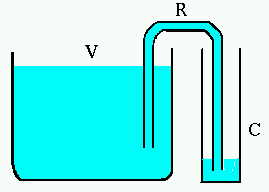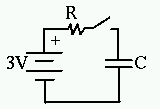

Let's compare a siphon system to an electrical circuit.
 |
In this device, the tank is trying to fill the bottle, and the siphon hose is limiting the flow. Eventually the bottle fills up, but it will take a long time if the tube is thin. |
 |
In this circuit, the battery is trying to push electricity into the capacitor, and the resistor is limiting the current. Eventually the capacitor charges up, but it will take a long time if the current is small. |
Then replace the 10 ohm resistor, with the 100 ohm resistor and again determine the charging time.
How do your results differ? Which resistor is like a thick siphon tube, and which is like a thin one?
The LED needs a certain voltage to turn on. It is like requiring
the bottle to be full to a certain level.
The LED won't go on until the capacitor is charged to
1.6V.